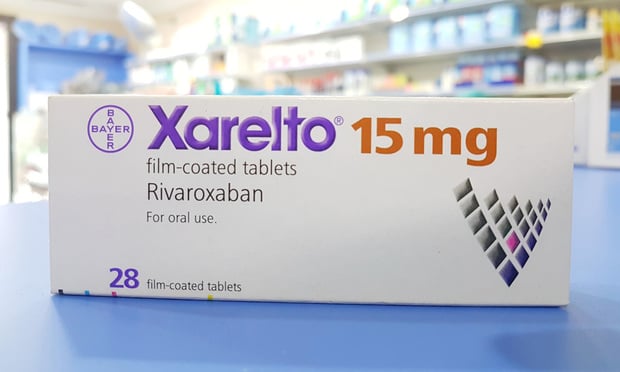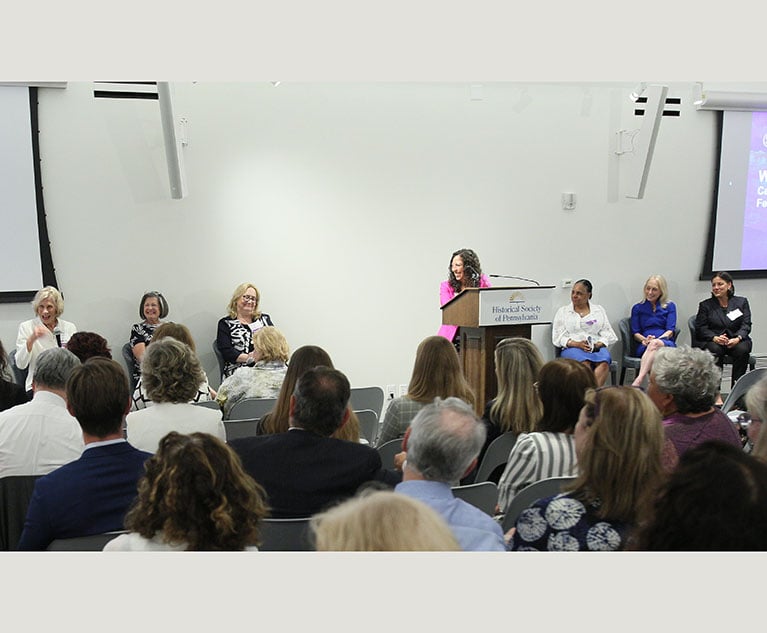Latest Xarelto Trial Focuses on Triple Blood Thinner Therapy Risks
The arguments came during opening statements in Russell v. Janssen Pharmaceuticals, which is the second Xarelto case to be tried in Philadelphia state court.
April 06, 2018 at 03:15 PM
4 minute read
 Photo: Shutterstock.com
Photo: Shutterstock.com Taking three blood thinner medications at once can be a necessary treatment for some patients, but including Xarelto in that mix can cause the risk of severe bleeding to skyrocket, attorneys suing two major drug companies on behalf of a man who suffered a near fatal bleed told a Philadelphia jury Friday.
The arguments came during opening statements in Russell v. Janssen Pharmaceuticals, which is the second Xarelto case to be tried in Philadelphia state court. The case focuses on plaintiff Daniel Russell, who suffered a bleed in 2011 while he was taking Xarelto along with Aspirin and Plavix, which is often called dual antiplatelet therapy.
According to Levin Papantonio Thomas Mitchell Rafferty & Proctor attorney Brian Barr, who made most of the plaintiff's opening statement to the jury, the drug companies knew that taking Xarelto along with a dual antiplatelet therapy significantly increased the risk of a severe bleed, but they did not disclose that to the medical community for fear it would hurt sales of the drug.
“Why did they stay silent? Why did they make a conscious decision to stay silent? Because they wanted to be able to sell Xarelto to people like Dan,” Barr said. “All of this pressure made Bayer and Janssen forget that their ultimate responsibility is to protect the patient.”
Russell's case represents the first chance for plaintiffs to argue that defendants Janssen and Bayer failed to adequately warn about the dangers of taking Xarelto when patients are also treating with a dual antiplatelet therapy. According to plaintiffs' liaison counsel, Michael Weinkowitz of Levin Sedran & Berman, about 25 percent of the more than 1,500 Xarelto cases pending in Philadelphia's mass tort program involve plaintiffs who took Xarelto in conjunction with Aspirin and Plavix.
Russell, a New Jersey resident, had been treating with dual antiplatelet therapy because he suffered acute coronary syndrome, which had previously required him to have a stent installed. In 2013, he was prescribed Xarelto to address a separate condition stemming from an irregular heartbeat, known as atrial fibrillation, which can often lead to stroke.
Barr told the jury that triple therapy, which is using an anticoagulant like Xarelto in addition to dual antiplatelet therapy, is relatively common in the United States with about 600,000 being treated this way. Finding that Xarelto created a severe bleeding risk “should have been shouted from the rooftops,” Barr said.
“They should have immediately put it in the label,” Barr said.
Attorney Brian Stekloff of Washington, D.C.-based Wilkinson Walsh + Eskovitz, who made most of the opening statement for the defendants, countered that the treating doctors were well aware that taking an anticoagulant in addition to two anti-platelet drugs would increase the chance of bleeding. However, even though doctors knew of the risks, patients suffering from both atrial fibrillation and acute coronary syndrome are at a high risk for developing strokes that are often more dangerous than gastrointestinal bleeds, which Russell suffered about a week after he started taking Xarelto.
“The doctors said Russell's risk of stroke was greater than his risk of a bleed,” Stekloff said. ”Both doctors stand by their decision, because nothing would have changed their decision.”
The Russell case is being tried several months after another Philadelphia jury awarded nearly $28 million to a woman who suffered a severe bleed while taking Xarelto along with Aspirin. That award, however, was later reversed by Philadelphia Court of Common Pleas Judge Michael Erdos, who is also presiding over Russell.
Three other Xarelto cases have been tried in federal court. Those cases all resulted in defense verdicts. Barr was co-lead counsel in the federal cases.
This content has been archived. It is available through our partners, LexisNexis® and Bloomberg Law.
To view this content, please continue to their sites.
Not a Lexis Subscriber?
Subscribe Now
Not a Bloomberg Law Subscriber?
Subscribe Now
NOT FOR REPRINT
© 2025 ALM Global, LLC, All Rights Reserved. Request academic re-use from www.copyright.com. All other uses, submit a request to [email protected]. For more information visit Asset & Logo Licensing.
You Might Like
View All

Phila. Med Mal Lawyers In for Busy Year as Court Adjusts for Filing Boom
3 minute read
'Recover, Reflect, Retool and Retry': Lessons From Women Atop Pa. Legal Community
3 minute read
EDPA's New Chief Judge Plans to Advance Efforts to Combat Threats to Judiciary
3 minute readTrending Stories
- 1Decision of the Day: Judge Dismisses Defamation Suit by New York Philharmonic Oboist Accused of Sexual Misconduct
- 2California Court Denies Apple's Motion to Strike Allegations in Gender Bias Class Action
- 3US DOJ Threatens to Prosecute Local Officials Who Don't Aid Immigration Enforcement
- 4Kirkland Is Entering a New Market. Will Its Rates Get a Warm Welcome?
- 5African Law Firm Investigated Over ‘AI-Generated’ Case References
Who Got The Work
J. Brugh Lower of Gibbons has entered an appearance for industrial equipment supplier Devco Corporation in a pending trademark infringement lawsuit. The suit, accusing the defendant of selling knock-off Graco products, was filed Dec. 18 in New Jersey District Court by Rivkin Radler on behalf of Graco Inc. and Graco Minnesota. The case, assigned to U.S. District Judge Zahid N. Quraishi, is 3:24-cv-11294, Graco Inc. et al v. Devco Corporation.
Who Got The Work
Rebecca Maller-Stein and Kent A. Yalowitz of Arnold & Porter Kaye Scholer have entered their appearances for Hanaco Venture Capital and its executives, Lior Prosor and David Frankel, in a pending securities lawsuit. The action, filed on Dec. 24 in New York Southern District Court by Zell, Aron & Co. on behalf of Goldeneye Advisors, accuses the defendants of negligently and fraudulently managing the plaintiff's $1 million investment. The case, assigned to U.S. District Judge Vernon S. Broderick, is 1:24-cv-09918, Goldeneye Advisors, LLC v. Hanaco Venture Capital, Ltd. et al.
Who Got The Work
Attorneys from A&O Shearman has stepped in as defense counsel for Toronto-Dominion Bank and other defendants in a pending securities class action. The suit, filed Dec. 11 in New York Southern District Court by Bleichmar Fonti & Auld, accuses the defendants of concealing the bank's 'pervasive' deficiencies in regards to its compliance with the Bank Secrecy Act and the quality of its anti-money laundering controls. The case, assigned to U.S. District Judge Arun Subramanian, is 1:24-cv-09445, Gonzalez v. The Toronto-Dominion Bank et al.
Who Got The Work
Crown Castle International, a Pennsylvania company providing shared communications infrastructure, has turned to Luke D. Wolf of Gordon Rees Scully Mansukhani to fend off a pending breach-of-contract lawsuit. The court action, filed Nov. 25 in Michigan Eastern District Court by Hooper Hathaway PC on behalf of The Town Residences LLC, accuses Crown Castle of failing to transfer approximately $30,000 in utility payments from T-Mobile in breach of a roof-top lease and assignment agreement. The case, assigned to U.S. District Judge Susan K. Declercq, is 2:24-cv-13131, The Town Residences LLC v. T-Mobile US, Inc. et al.
Who Got The Work
Wilfred P. Coronato and Daniel M. Schwartz of McCarter & English have stepped in as defense counsel to Electrolux Home Products Inc. in a pending product liability lawsuit. The court action, filed Nov. 26 in New York Eastern District Court by Poulos Lopiccolo PC and Nagel Rice LLP on behalf of David Stern, alleges that the defendant's refrigerators’ drawers and shelving repeatedly break and fall apart within months after purchase. The case, assigned to U.S. District Judge Joan M. Azrack, is 2:24-cv-08204, Stern v. Electrolux Home Products, Inc.
Featured Firms
Law Offices of Gary Martin Hays & Associates, P.C.
(470) 294-1674
Law Offices of Mark E. Salomone
(857) 444-6468
Smith & Hassler
(713) 739-1250





